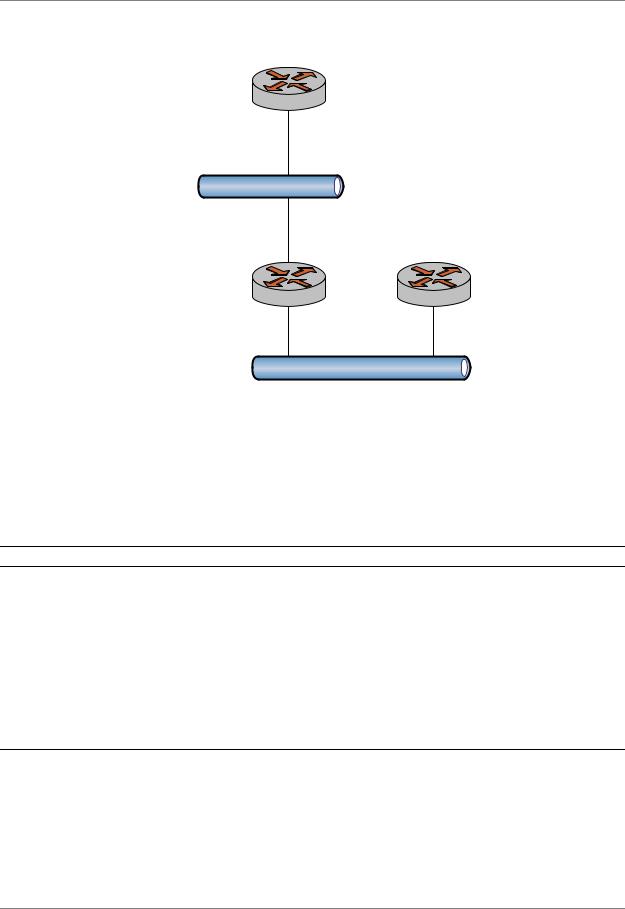
- •Contents
- •Quick List of Commands
- •List of Examples
- •Preface
- •Intended Audience
- •Organization of This Guide
- •Document Conventions
- •Vyatta Publications
- •Chapter 1: Forwarding and Routing
- •Forwarding and Routing Commands
- •clear ip prefix-list
- •clear ipv6 prefix-list
- •ping <host>
- •reset ip route cache
- •reset ipv6 route cache
- •show ip forwarding
- •show ip route
- •show ip route cache
- •show ip route connected
- •show ip route forward
- •show ip route kernel
- •show ip route static
- •show ip route summary
- •show ip route supernets-only
- •show ip route table <table>
- •show ipv6 route
- •show ipv6 route bgp
- •show ipv6 route cache
- •show ipv6 route connected
- •show ipv6 route forward
- •show ipv6 route kernel
- •show ipv6 route ripng
- •show ipv6 route static
- •show ipv6 route summary
- •show monitoring protocols rib
- •show table
- •traceroute <host>
- •Chapter 2: Static Routes
- •Static Route Configuration
- •Static Routes Overview
- •Configuring Static Routes
- •Floating Static Routes
- •Showing Static Routes in the Routing Table
- •Static IPv6 Route Configuration
- •Verify That IPv6 Forwarding is Enabled
- •Add the Default IPv6 Route
- •Add a Static IPv6 Route
- •Confirm Connectivity
- •Static Route Commands
- •protocols static route <subnet> blackhole
- •protocols static route6 <subnet> blackhole
- •protocols static table <table> route <subnet> blackhole
- •protocols static table <table> route6 <subnet> blackhole
- •Glossary of Acronyms

Chapter 2: Static Routes |
Static IPv6 Route Configuration 40 |
|
|
|
|
Floating Static Routes
Usually, static routes have a relatively short administrative distance—typically 1, and usually shorter than the administrative distances for dynamic (learned) routes. A “floating” static route is a static route with an administrative distance greater than that for dynamic routes.
You can configure a static route to be a floating route by setting the administrative distance higher than the distance applied to the routes in your dynamic routing protocol. This renders the static route less desirable than a dynamic route. At the same time, if the dynamic route is lost, the static route is available to take over traffic, which can be forwarded through the static route as an alternate path.
Showing Static Routes in the Routing Table
To display route information, use the show ip route command. To show just static routes, use the show ip route static filter, as shown in Example 2-2.
Example 2 2 Showing static routes in the routing table
vyatta@R1:~$ show ip route static
Codes: K kernel route, C connected, S static, R RIP, O OSPF, I ISIS, B BGP, > selected route, * FIB route
S>* 11.0.0.0/8 [1/0] via 172.16.0.26, eth0 vyatta@R1:~$
Static IPv6 Route Configuration
Figure 2-2 shows an IPv6 network with three nodes. In this example we will show configuration of the nodes using static routes to enable R2 and R4 to communicate via R1.
Basic Routing |
6.5R1 v01 |
Vyatta |

Chapter 2: Static Routes |
Static IPv6 Route Configuration 41 |
Figure 2 2 Static IPv6 routing example |
|
R4 |
|
eth0 |
|
2001:db8:1::4 |
|
2001:db8:1::/64 |
|
2001:db8:1::1 |
|
eth0 |
|
R1 |
R2 |
eth2 |
eth0 |
2001:db8:2::1 |
2001 :db8:2::2 |
2001:db8:2::/64
Verify That IPv6 Forwarding is Enabled
In order for R1 to be able to pass data between interfaces eth0 and eth2 (i.e., between R4 and R2) it must be configured to enable forwarding. To determine if forwarding is enabled, perform the following step in operational mode.
Example 2 3 Determine if forwarding is enabled on R1
Step |
Command |
|
|
Display the state of IPv6 |
vyatta@R1:~$ show ipv6 forwarding |
forwarding on R1. |
ipv6 forwarding is off |
|
|
If forwarding is not enabled, as is the case in Example 2-3, the system must be configured to enable forwarding. To enable forwarding, perform the following steps in configuration mode.
Example 2 4 Enable forwarding on R1
Step |
Command |
|
|
Enable forwarding on R1. |
vyatta@R1# delete system ipv6 disable forwarding |
|
|
Commit the change. |
vyatta@R1# commit |
|
|
Basic Routing |
6.5R1 v01 |
Vyatta |

Chapter 2: Static Routes |
Static IPv6 Route Configuration 42 |
|
|
|
|
Example 2 4 Enable forwarding on R1
Change to operational mode |
vyatta@R1# exit |
|
exit |
|
vyatta@R1:~$ |
|
|
Display the state of IPv6 |
vyatta@R1:~$ show ipv6 forwarding |
forwarding on R1. |
ipv6 forwarding is on |
|
|
Add the Default IPv6 Route
On R4, all traffic that is not routed elsewhere will be sent to R1. To configure the default route, perform the following steps in configuration mode.
Example 2 5 Add the default route on R4
Step |
Command |
|
|
Add the default route on R4. |
vyatta@R4# set protocols static route6 ::/0 next hop |
|
2001:db8:1::1 |
|
|
Commit the change. |
vyatta@R4# commit |
|
|
Change to operational mode. |
vyatta@R4# exit |
|
exit |
|
vyatta@R4:~$ |
Verify the default route in the routing table.
vyatta@R4:~$ show ipv6 route
Codes: K kernel route, C connected, S static, R RIPng, O OSPFv3,
I ISIS, B BGP, * FIB route.
S>* ::/0 [1/0] via 2001:db8:1::1, eth0 C>* ::1/128 is directly connected, lo
C>* 2001:db8:1::/64 is directly connected, eth0 C * fe80::/64 is directly connected, eth1
C>* fe80::/64 is directly connected, eth0 K>* ff00::/8 is directly connected, eth0
Basic Routing |
6.5R1 v01 |
Vyatta |

Chapter 2: Static Routes |
Static IPv6 Route Configuration 43 |
|
|
|
|
Add a Static IPv6 Route
As an alternative to the default route we created on R4, we’ll create a static route on R2. To configure a static route to the 2001:db8:1::/64 network, perform the following steps in configuration mode.
Example 2 6 Add a static route on R2
Step |
Command |
|
|
|
|
Add a static route on R2. |
vyatta@R1# |
set protocols static route6 2001:db8:1::/64 |
|
next hop 2001:db8:2::1 |
|
|
|
|
Commit the change. |
vyatta@R1# |
commit |
|
|
|
Change to operational mode. |
vyatta@R1# |
exit |
|
exit |
|
|
vyatta@R2:~$ |
|
Verify the static route in the routing table.
vyatta@R2:~$ show ipv6 route
Codes: K kernel route, C connected, S static, R RIPng, O OSPFv3,
I ISIS, B BGP, * FIB route.
C>* ::1/128 is directly connected, lo
S>* 2001:db8:1::/64 [1/0] via 2001:db8:2::1, eth0 C>* 2001:db8:2::/64 is directly connected, eth0
C * fe80::/64 is directly connected, eth1 C>* fe80::/64 is directly connected, eth0 K>* ff00::/8 is directly connected, eth0
Confirm Connectivity
To confirm that R2 and R4 can communicate, use the ping command. To confirm connectivity between R2 and R4, perform the following step in operational mode.
Example 2 7 Confirm connectivity between R2 and R4
Step |
Command |
|
|
|
|
Ping R4 from R2. |
vyatta@R2:~$ ping 2001:db8:1::4 |
|
|
PING 2001:db8:1::4(2001:db8:1::4) 56 data bytes |
|
|
64 |
bytes from 2001:db8:1::4: icmp_seq=1 ttl=63 time=5.65 ms |
|
64 |
bytes from 2001:db8:1::4: icmp_seq=2 ttl=63 time=0.382 ms |
|
^C |
|
|
2001:db8:1::4 ping statistics |
|
|
2 packets transmitted, 2 received, 0% packet loss, time 1011ms |
|
|
rtt min/avg/max/mdev = 0.382/3.016/5.650/2.634 ms |
|
|
|
|
Basic Routing |
6.5R1 v01 |
Vyatta |

Chapter 2: Static Routes |
Static IPv6 Route Configuration 44 |
|
|
|
|
As an alternative, use traceroute to verify that the goes from R2 to R1 to R4. To confirm connectivity between R2 and R4 through R1 using traceroute, perform the following step in operational mode.
Example 2 8 Confirm connectivity between R2 and R4 via R1
Step |
Command |
|
|
|
|
|
|
|
|
|
|
|
|
||||
Trace the route from R2 to R4. |
vyatta@R2:~$ traceroute 2001:db8:1::4 |
|
|
|
||||
|
traceroute to 2001:db8:1::4 (2001:db8:1::4), 30 hops max, 40 |
|||||||
|
byte |
packets |
|
|
|
|
|
|
|
1 |
(2001:db8:2::1) |
4.448 |
ms |
4.148 |
ms |
4.092 |
ms |
|
2 |
(2001:db8:1::4) |
4.297 |
ms |
4.306 |
ms |
4.308 |
ms |
|
|
|
|
|
|
|
|
|
Basic Routing |
6.5R1 v01 |
Vyatta |
